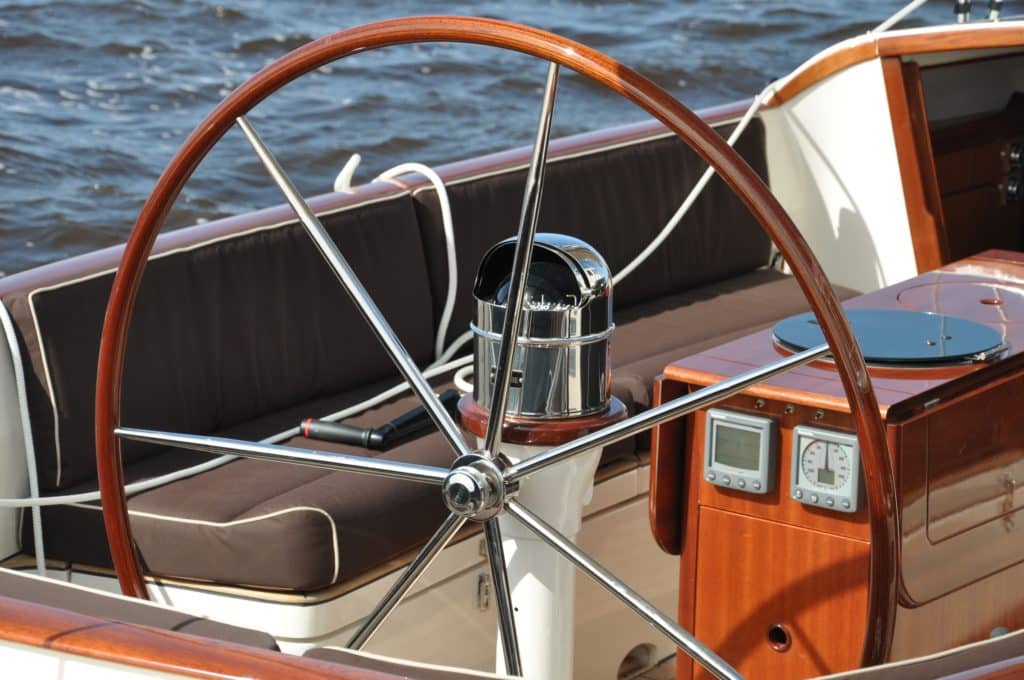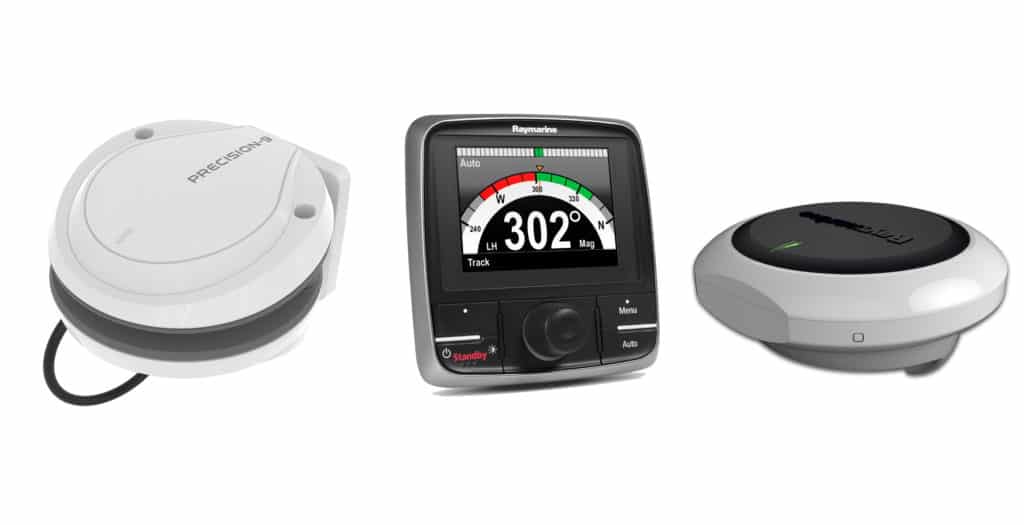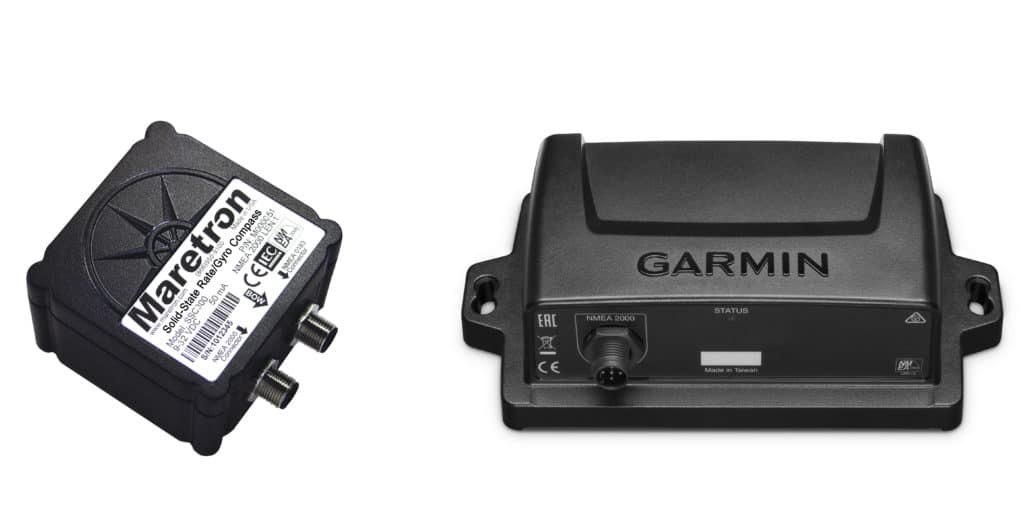
Years ago, my parents owned a C&C 37 that we cruised extensively offshore, often sailing from our Connecticut home to points north such as Maine and Nova Scotia. While the boat was quick on most points of sail, her tumblehome hull form meant that she was a squirrelly ride off the breeze, especially in a quartering seaway with her autopilot driving. I can remember more than a few moments of lurking fear as Windancer’s stern would lift, and the corkscrew ride would commence.
Sometimes the autopilot would keep pace, but other times its fluxgate compass, which reported its heading information at a rate of just 1 hertz, or once per second, would lag in big seas, causing the autopilot to “hunt” for its proper course. The results could get ugly, especially if we were sailing deep angles.
Granted, this was in the early 1990s, when autopilots weren’t as robust as current models. Today’s solid-state compasses offer significantly faster reporting rates, while also providing other benefits that extend far past an autopilot’s performance.
Technology in Flux
Fluxgate compasses have been widely used since the 1930s to supply analog heading data to a vessel’s autopilot, and as technology evolved, to its navigation system via an electronic signal. While effective, fluxgate compasses suffer from several physical limitations, including interference from ferrous metals; declination issues when used at higher latitudes; and in boisterous conditions, “gimbal lock,” or the inability to compensate for a boat’s movement. Also, as previously mentioned, many fluxgate compasses typically use a 1-hertz reporting rate, which will produce sluggish results in brisk conditions. To improve performance, in regard to response times at least, some compass manufacturers, including Digital Yacht and KVH, offer models with 10-hertz reporting rates.
Other electronics manufacturers have taken a different tack and have developed faster, more-accurate electronic compasses that rely on solid-state componentry to provide better heading-reference information, irrespective of sea state or latitude.
As with many marine-electronics offerings, the technology that enables solid-state sensors trickled down from elsewhere — in this case, the aviation industry. Altitude Heading Reference System (AHRS) technology was created to replace older mechanical gyroscopic instruments for pilots. This technology employs solid-state or micro electro-mechanical systems (MEMS), including microscopic mechanical devices with tiny moving components (typically measured between 0.001 and 0.1 millimeters), a microprocessor, and microsensors to measure pitch, roll and yaw.
The consumer-electronics market later embraced AHRS technology for use in the inertial navigation systems that are found in smartphones, tablets and other devices, thus increasing these sensors’ availability and reducing costs.
Today’s solid-state compasses rely on sophisticated componentry, including accelerometers, which measure angular velocity in all three axes; gyroscopes, which monitor pitch, roll and yaw; and magnetometers, which measure azimuth information. The net result is a significantly faster generation of compasses that report at speeds ranging from 10 to 30 hertz or more. Heading information is accurate to 1 or 2 degrees across nine different axes, and these devices will talk directly with your vessel’s autopilot and its NMEA 0183, NMEA 2000 or other proprietary data backbone.
There are currently a few solid-state compasses available for the recreational marine-electronics market. Players include Airmar’s GH2183 and H2183 sensors, B&G’s Precision 9, Garmin’s nine-axis Heading Sensor, Maretron’s SSC300 solid-state compass and Raymarine’s EV1. Each of these provide night-and-day performance improvements over Windancer’s old fluxgate compass. Additionally, Furuno’s PG700 heading sensor is a “hybrid” compass that uses a solid-state accelerometer and a flux-gate magnetometer whose core continually floats, thanks to an “infinite” axis design. According to Eric Kunz, Furuno’s senior product manager, this hybrid solution offers “the same accuracy of the latest MEMS designs without the computational requirements to achieve it.”

At Work at Sea
“The biggest jump is in autopilot performance,” says Jim McGowan, the Americas marketing manager at FLIR Maritime, which includes Raymarine. Older-generation autopilots blindly drove their course using only their fluxgate compass for their eyes, explains McGowan. Now, with a calibrated EV1 compass networked to a Raymarine Evolution autopilot, the system can predict vessel motion and pre-emptively move the rudder to maintain its heading.
Other manufacturers note a similar spike in performance when their autopilots are paired with a fast, accurate heading-reference system. “Our Precision 9 is quick to stabilize at a new heading after a course change,” says Mark Harnett, a product manager at Navico, B&G’s parent company. “This translates to the autopilot, which stabilizes faster and gets onto the new heading faster.” According to Harnett, when B&G’s Precision 9 was bench-tested against its sister-brand Simrad’s RC42 fluxgate compass, which sells for $645, and its GC80 commercial-grade gyrocompass, which goes for $15,000, the Precision 9’s performance was much closer to the GC80 than the RC42. Those are impressive results, given that the Precision 9 costs within a few dollars of the RC42’s fetching price.
Accurate heading-reference information is also critical to a boat’s navigation system, specifically with respect to stabilizing an electronic chart on a chart-plotter screen when a vessel isn’t moving and the GPS can’t generate course-over-ground information. If a vessel doesn’t have a heading-reference system, says Harnett, charts that are viewed in a heads-up orientation while the vessel is at anchor will move around on-screen; with a sensor, charts that are viewed in a north-up presentation will be stable, since they are referenced north, however, says Harnett, “you’ll find your boat icon will be doing a little crazy circle all the time.”
Likewise, a boat’s radar will also benefit from a fast and accurate heading-reference system. According to Dave Dunn, Garmin’s director of marine sales and marketing, a vessel at anchor will experience alignment issues between its radar and chart plotter if the navigator is attempting to use the plotter’s radar-overlay feature. Without a heading sensor, says Dunn, “the whole picture will spin, and the radar overlay is useless.” Fortunately, this is an easy fix. “With a heading sensor, the radar will always be lined up with the chart,” says Dunn.
Cruisers who use their radar’s Automatic Radar Plotting Aid (ARPA) and Mini-Automatic Radar Plotting Aid (MARPA) target-tracking features can also experience headaches if they don’t have an accurate heading-reference sensor. While ARPA and MARPA are powerful tools, they typically require a 10-hertz heading-update rate, which an older, slower fluxgate compass can’t support. For example, says McGowan, a radar-equipped boat with a fluxgate compass that’s executing a jibe or tack could experience a lag between its chart plotter and radar, causing the radar to drop its targets.
McGowan says that ARPA-equipped radars can typically reacquire dropped targets, but MARPA targets, which have to be manually entered, are usually lost. Here, however, the significantly faster updating rates offered by contemporary solid-state compasses allow a networked radar to quickly and constantly crunch accurate vector calculations to its tracked targets, reducing the chance of losing them while maneuvering.

Smarter Devices
While these faster, more-accurate solid-state compasses deliver better heading-reference information, they can also improve the capabilities of your navigation and instrumentation system. For example, Raymarine’s EV1 removes vessel movement from its heading information. “Our new Sensor Fusion software stabilizes the navigation data that comes through the network,” says McGowan. The EV1’s sensor measures vessel movement to one-thousandth of a degree. “Pitch and roll will affect the GPS sensor, which is moving as the boat moves, and will sense change as speed- or course-over-ground changes. Now, we send the GPS data through the EV1, which corrects the data and sends it to the MFD.” Interestingly, the EV1’s processor can perform these same corrections to wind data, allowing cruisers to think in terms of true-wind angles and speeds, much like racing sailors.
Likewise, racers often focus on a boat’s heel angle because it helps them to quickly feel if their sails are properly trimmed and if weight is well-situated. Today’s solid-state compasses can output heel angle as a deliverable metric. While cruisers aren’t likely to stack sail bags to windward or ask their first mate to spend the graveyard watch on the rail, heel angle is a great, at-a-glance metric for determining if your sails are properly trimmed and if the boat’s over- or underpowered.
When it comes to installation, each manufacturer has its own requirements, but, generally speaking, adding a solid-state compass is fairly straightforward. “It’s an easy, two-step DIY job, thanks to its NMEA 2000 connectivity,” says Garmin’s Dunn, and his colleagues agree when discussing their own products.
Garmin’s new compass, as well as B&G’s Precision 9 and Raymarine’s EV1, all come with an IPX7 rating, allowing them to survive what Dunn describes as “bilge conditions.” The best approach is to mount these compasses amidships and on the centerline.
Once installed, solid-state compasses are also dramatically easier to calibrate than traditional fluxgate compasses. Manufacturers provide setup wizards, and the devices self-calibrate by running a series of background calculations as you cruise, or require just a single circle to gain their bearings.
One important consideration to keep in mind is that solid-state compasses, like traditional compasses, are still susceptible to magnetic interference from ferrous metals.
“Any iron or steel — ferrous metals — will impact solid-state MEMS,” says Harnett. Others agreed. “The EV1’s sensor, at its heart, is still a magnetic device, so most of the rules that apply to other compasses apply to an EV1 as well,” notes McGowan. Still, the EV1 is constantly self-calibrating in the background. “That being said, the electronics that are in it are much, much smarter when it comes to calculating deviation. The sensors are a lot more sensitive to be able to pick out the true magnetic flux versus objects around it.”
While it’s true that solid-state compasses don’t offer the same level of performance as the mechanical gyrocompasses found aboard many merchant ships, they can be purchased for a fraction of the cost. Models start at about $600; their big-ship siblings can go for 20 or 25 times more. Moreover, solid-state compasses also eliminate the gimbal-lock, where the compass physically bottoms-out in rough seas, and which can damage fluxgate compasses over time, says McGovern.
If you’re thinking of upgrading an autopilot or looking to add some extra horsepower to your navigation capabilities without having to spend a small fortune, consider adding a solid-state compass. Given the simple DIY installation job — not to mention the benefits that these compasses can provide — there’s little reason not to add one of these units to your spring commissioning list. And should you have an older IOR-style cruiser/racer like Windancer, upgrading your autopilot and heading-reference systems is a must, especially if you’re not fond of crash jibes at 0200 hours on some windy, wave-tossed night.
David Schmidt is CW’s electronics editor.








